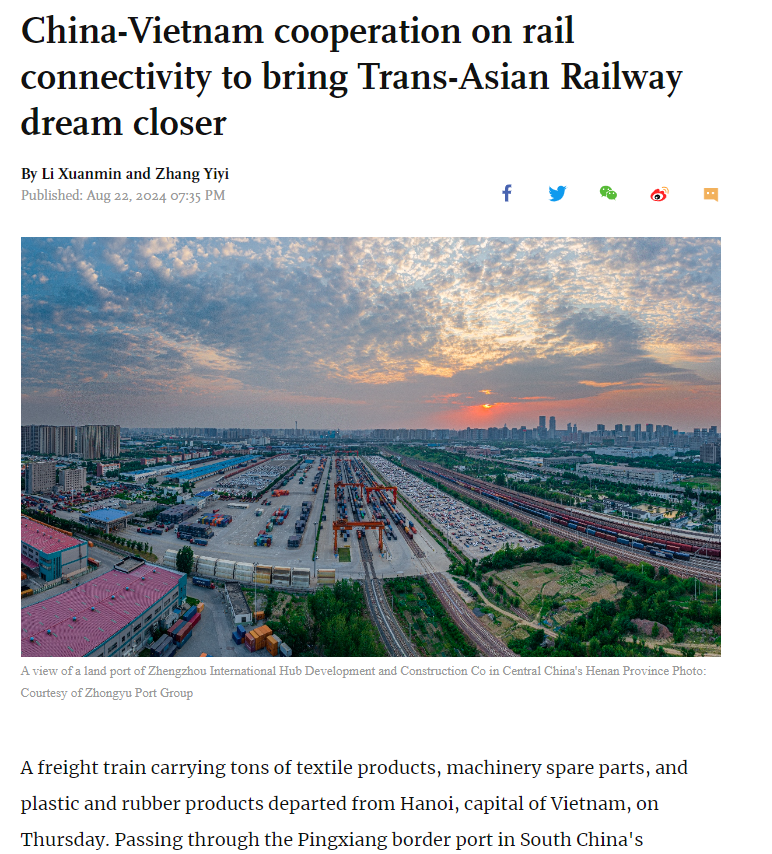LATEST INSIGHTS
Your Present Location: LATEST INSIGHTS[GT] Wang Yiwei: China-Vietnam cooperation on rail connectivity to bring Trans-Asian Railway dream closer
Source: Global Times Published: 2024-08-22

By Li Xuanmin and Zhang Yiyi
A freight train carrying tons of textile products, machinery spare parts, and plastic and rubber products departed from Hanoi, capital of Vietnam, on Thursday. Passing through the Pingxiang border port in South China's Guangxi Zhuang Autonomous Region, the train will arrive at Zhengzhou, capital of Central China's Henan Province, in about a week. On the return journey, the freight train will be loaded with China-made food, plant products, and gypsum, destined for Hanoi.
Scheduled cargo trains that operate between Zhengzhou and Hanoi have been running every day since July 2023, amid soaring trade volume between China and Vietnam, a representative from Zhengzhou-based Zhongyu Port Group told the Global Times on Wednesday.
In the first eight months of 2024, a total of 36 trains have run between China and Vietnam, representing a growth of 800 percent year-on-year, underscoring the close economic ties between the two countries. China is currently the largest trading partner of Vietnam, while Vietnam is also the largest trading partner of China in ASEAN.
Industry insiders are optimistic about the prospects for China-Vietnam infrastructure connectivity, which they believe will be consequential not only for promoting investment and trade flow between the two neighbors, but also for the further development of the Trans-Asian Railway (TAR) network in the Southeast Asia, which is key to ensuring global supply chain stability amid rising geopolitical tensions.
China and Vietnam on Tuesday issued a joint statement on further strengthening the China-Vietnam comprehensive strategic cooperative partnership and promoting the building of a community with a shared future between the two countries.
The two sides agreed to reach out to each other and help each other succeed and move faster to synergize the Belt and Road Initiative (BRI)with the Two Corridors and One Economic Circle strategy. Also, China has agreed to provide support in drafting the planning for the Lang Son-Hanoi and Mong Cai-Ha Long-Haiphong standard-gauge railway projects, as well as the feasibility study report for the Lao Cai-Hanoi-Haiphong standard-gauge railway project in Vietnam.
'China-Vietnam trade volume has been continuing to expand, especially after the RCEP came into force in January 2022. There's also great potential to be tapped. In the future, the China-Vietnam freight train is expected to operate more steadily and with increased frequency, gradually being connected with other rail services including China-Europe and China-Central Asia freight trains, and offering a strong transportation network for further elevation of bilateral trade,' the Zhongyu Port Group representative said.
Greater connectivity
A representative from China Railway Kunming Group Co told the Global Times that, with regards to the China-Vietnam connectivity, the company will 'strive to build a convenient international transportation corridor that connects the Southeast Asia and integrates with the construction of China-Indochina Peninsula Economic Corridor.'
To date, the Kunming railway operator has transported a total of 297,600 tons of cross-border cargos via the Hekou-Lao Cai railway, up 76.81 percent year-on-year, according to the group.
In April, Vietnam's Ministry of Planning and Investment said that the country aims to start building two high-speed rail lines linking its capital Hanoi with China before 2030, the CNN reported.
Also in April, Vietnam said it was 'seeking to learn from China to develop its first high-speed railway network and had sent its officials to work with Chinese railway companies,' according to the report by CNN.
'The positive attitude is a drastic departure from Vietnam's past hesitation, which shows that mutual political trust between the two countries has been elevated to new high,' Wang Yiwei, a professor at the School of International Relations at Renmin University of China, told the Global Times.
'It is without a doubt that for Vietnam, strengthening cooperation with China is practical and brings mutual benefits. The spillover effect of the China-Laos Railway and the Jakarta-Bandung High-Speed Railway also plays a demonstration role,' he added.
A step closer to TAR dream
Observers noted that Vietnam's internal rail lines consist of meter-gauge, standard-gauge, and broad-gauge, which requires significant effort to coordinate between these standards and undermines the country's rail freight capacity.
Thus, unifying the main transportation link with standard-gauge would largely enhance the country's railway efficiency and potential cargo capacity.
Vietnam has emerged as a global manufacturing hub in recent years.
As the old saying goes - 'when the train whistles, wealth pours in,' analysts also pointed out that upgrading the rail link with China could reshape Vietnam's trading landscape and facilitate the export diversification push of the country. This would allow Vietnam to directly connect with Europe, another major export destination.
Throughout Southeast Asia, the extensive TAR network, which is envisioned to pass through the region's agricultural and industrial heartlands, is gradually expanding under the BRI.
In December 2021, the China-Laos Railway, the first leg of central route of the TAR network was put into operation.
TAR's central line starts from Kunming and travels through Laos, connecting with Thailand. From Thailand, the route can extend further to Malaysia and Singapore.
Vietnam sits at the TAR's eastern line, which could eventually connect China, Vietnam, Cambodia and Thailand, from where the railway continues to link up with other countries such as Malaysia and Singapore.
Wang stressed that under the BRI framework, China has a massive role to play in building overarching railway networks, at a time when Southeast Asia is in urgent need of infrastructure development to drive its economic transformation.
For example, China has accumulated rich experience in building railways in tropical environment and high mountains. The country also offers the most competitive and most cost-effective solutions for rail construction, he noted.























































































 京公网安备 11010802037854号
京公网安备 11010802037854号





